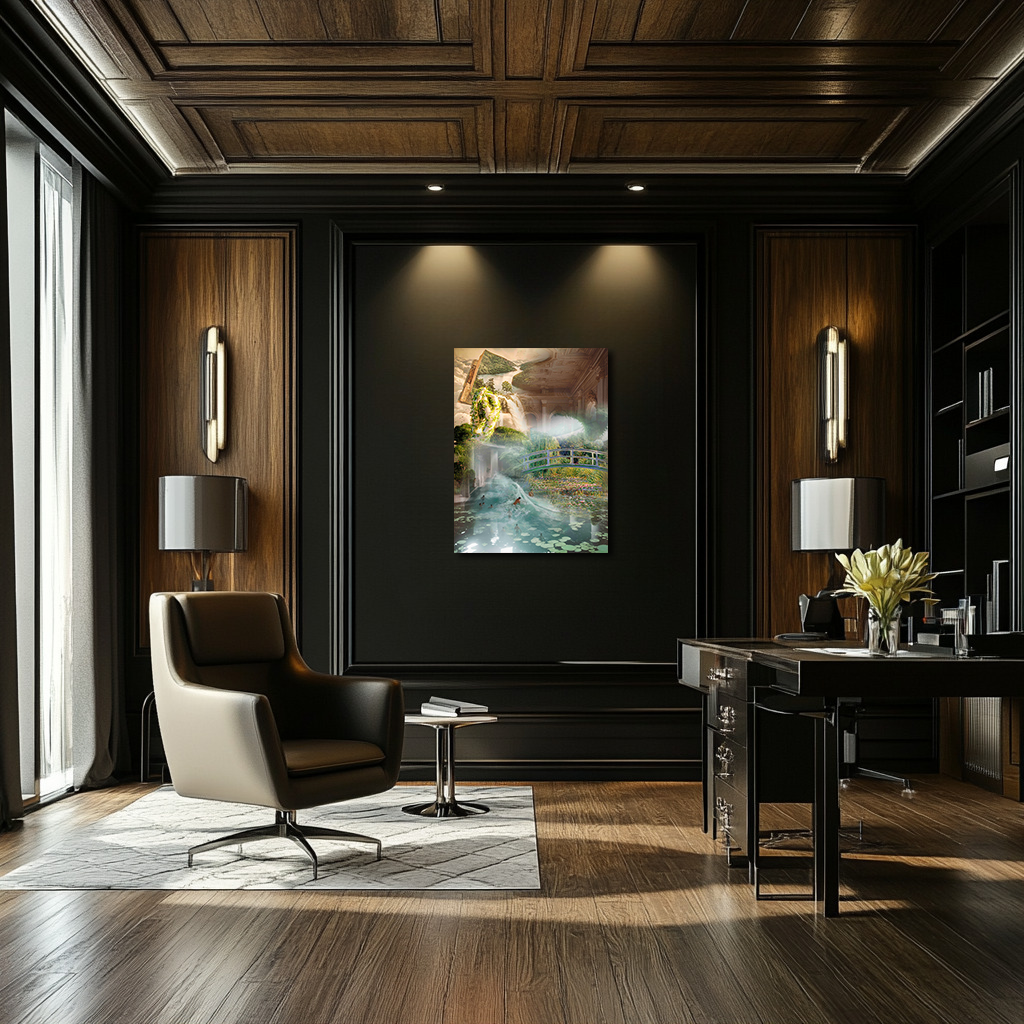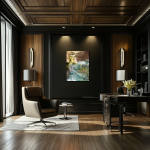Passage Through Reflections: Monet's Dream of the Japanese Bridge
This surreal reinterpretation of Monet’s The Japanese Bridge (The Water-Lily Pond) (1899) blends the peaceful tranquility of the iconic garden with a fantastical dreamscape. Opulent architecture merges with cascading waterfalls and lush greenery, surrounding Monet’s delicate bridge and serene lilies. Beneath the reflective waters, human figures joyfully swim, symbolizing active immersion into perception itself. The artwork explores the boundary between imagination and reality, illustrating the endless potential of human creativity, dreams, and the transformative power of how we perceive our world.
Please see Below for Details…
Hotline Order:
Mon - Fri: 07AM - 06PM
404-872-4663
Claude Monet’s The Japanese Bridge (The Water-Lily Pond) (1899) was always more than an idyllic scene painted in vibrant greens, shimmering blues, and gentle pastels; it was an intimate reflection on the delicate interplay of light, color, and the quiet poetry of nature. Monet's dedication to capturing the ever-shifting reflections on water transformed his beloved garden in Giverny into an emblem of tranquility, contemplation, and the ceaselessly evolving perception of beauty. With each brushstroke, he dissolved the boundaries between reality and reflection, creating a world suspended gently between water and sky, tangible presence and ephemeral mirage.
This surreal reinterpretation expands Monet's original vision, delving deeper into the dream-like potential of his celebrated garden, transforming it into a fantastical realm where reality gracefully yields to imagination. The composition becomes a visual symphony, weaving together Monet’s iconic water lilies and bridge with grand architectural elements, natural wonders, and surreal imagery. Each component harmoniously overlaps and merges, creating a unified yet endlessly complex exploration of perception, memory, and dreams.
At the center of the artwork is Monet’s familiar Japanese bridge, gently arching over the serene lily pond. Rendered in soft, fluid strokes that recall Monet’s own impressionistic touch, the bridge becomes both literal and symbolic. Bathed in dappled sunlight filtering through lush greenery, its gentle curve evokes a sense of serenity and meditation, an invitation to cross into a world beyond the ordinary. Surrounding the bridge, water lilies bloom radiantly on the pond's reflective surface, their delicate petals floating gently like fleeting thoughts or memories, each subtly blurred, echoing Monet’s deep fascination with the transient nature of visual experience.
Yet, this peaceful garden scene does not stand alone. It is seamlessly integrated into a much grander, surreal landscape—one that defies conventional boundaries and perspective. Above the tranquil pond, opulent architectural elements cascade downward, blending effortlessly with cascading waterfalls and lush forests, creating a spectacular, dreamlike juxtaposition between civilization and wilderness, structure and nature. Intricate ceilings adorned with lavish ornamentation softly dissolve into mist and greenery, framing Monet’s pond within a palatial yet otherworldly context.
From high above, a magnificent waterfall pours forth, emerging from a floating landscape suspended improbably in mid-air. The water flows gracefully, bridging the gap between worlds as it plunges into the garden below, bringing with it a sense of perpetual renewal and cleansing. This powerful cascade symbolizes the fluidity of time, the ceaseless cycle of perception and memory, and the boundless imagination that Monet's works continue to inspire. The flowing water seamlessly merges with the tranquil pond, reinforcing the interconnectedness of all experiences—both peaceful and turbulent.
Beneath the gentle arc of the Japanese bridge, the water becomes vibrant with human activity—people swimming, splashing, and immersing themselves joyfully within Monet's reflective vision. Their presence introduces a dynamic element to this contemplative scene, emphasizing that the artwork is not merely to be observed, but experienced. These figures symbolize our own immersion into Monet’s world, suggesting that perception itself is an active, participatory experience—a bridge we continually cross between the internal and external, imagination and reality.
Light itself plays a central role, filtering softly through the composition, illuminating various elements and creating gentle reflections. This careful interplay of luminosity and shadow, drawn from Monet’s original techniques, emphasizes the shifting nature of visual experience. Shadows of architecture blend gently with reflections from the water, and sunlight dapples through leaves, blurring distinctions between solid forms and ephemeral reflections. The overall effect is a luminous, dreamlike quality that captures the very essence of Monet’s enduring fascination with perception’s fragility.
In this artwork, my intention was to honor Monet’s profound exploration of reflection and perception, elevating it to a fantastical plane that embodies the boundless possibilities of imagination. The Japanese bridge becomes more than a structure—it transforms into a metaphorical threshold into dreams, memory, and the subconscious. The grand architecture, waterfalls, and surreal elements further enrich this narrative, illustrating how imagination and reality interweave seamlessly within the human experience.
Ultimately, this surreal reinterpretation serves as an invitation to explore beyond Monet’s garden, to see his familiar vision anew, through the lens of dreams. It encourages us to cross bridges not only physically but perceptually—to immerse ourselves in the fluidity of experience, to embrace the ephemeral beauty of life, and to find wonder in the endless interplay between what we see and how we imagine it.
Add your review
Your email address will not be published. Required fields are marked *
Please login to write review!
Looks like there are no reviews yet.








